39 Tips to Prepare for a Mountain Bike Race
Mountain biking is a great way to get outside, enjoy the scenery, and get some exercise. But if you want to be successful in mountain biking races, there are a few things you need to do to prepare. Here are thirty tips that will help you get ready for your next race.
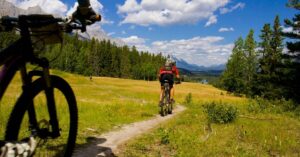
1. Train for the race distance
When it comes to mountain bike racing, one of the best tips is to train for the race distance. This may seem like common sense, but you would be surprised how many people try to go into a race without properly preparing their body for the distance. Not only will this lead to a poor performance, but it can also lead to injury. By training for the race distance, you’ll not only be mentally and physically prepared for the challenge, but you’ll also increase your chances of crossing the finish line first.
Mountain bike races can range anywhere from 10 miles to 100 miles, so it’s important to be properly prepared for the distance you’ll be racing. If you’re new to mountain biking, start by doing some shorter rides and gradually build up to the race distance. Depending on the length of the race, you’ll need to be able to sustain a certain level of endurance. If you’re not used to riding for long periods of time, it can be tough to build up that endurance.
That’s why it’s important to include some long-distance rides in your training. By gradually increasing the distance of your rides, you’ll give your body time to adjust and build up the necessary endurance. And when race day comes, you’ll be ready to go the distance.
So if you’re looking to step up your mountain bike racing game, make sure to put in the miles and train for the race distance. Your body will thank you for it!
2. Build endurance with long rides
In order to build endurance for a mountain bike race, it’s important to do some long rides. This is because the race itself is going to be a long and endurance will be key to crossing the finish line. There are a few different ways to go about doing long rides. One option is to find a trail that is the same length as the race you’re training for. If you’re training for a 50-mile race, try to find a 50-mile trail to ride on. Another option is to do out-and-back rides on shorter trails. For example, if you’re training for a 50-mile race, you could do 5 out-and-back rides on a 10-mile trail.
No matter which option you choose, the key is to gradually increase the distance of your long rides. If you try to do too much too soon, you’ll end up overtraining and risking injury. Start with shorter distances and work your way up. And make sure to give yourself plenty of rest in between long rides. This will help your body recover and be ready for the next one.
Long rides help build your endurance and will give you a chance to practice being on the bike for extended periods of time. Mountain bike races are often longer than road bike races, so it’s important to make sure you can comfortably ride for several hours. By doing long rides on a regular basis, you’ll be able to increase your endurance and be ready for anything on race day.
3. Improve your strength and power with hill repeats
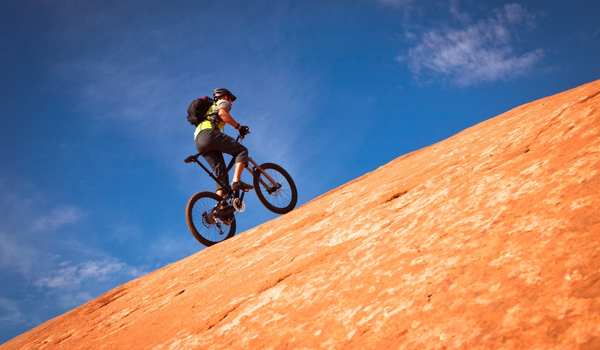
Hill repeats are a great way to improve your strength and power for mountain biking. They are also a great way to mix up your training and keep things interesting. If you’re not familiar with hill repeats, they are simply riding up a hill as fast as you can and then riding back down at a slow, easy pace. You can do them on any type of terrain, but they are typically done on dirt roads or singletrack trails.
One of the benefits of hill repeats is that they help you learn how to control your speed when going downhill. This is an important skill to have for mountain biking, as you’ll often be coming down hills during a race. By doing hill repeats, you’ll not only build your strength and power, but you’ll also learn how to control your speed on the descent.
4. Get familiar with the course
If you’re racing on a new course, it’s important to get familiar with it before race day. This way, you’ll know what to expect and won’t be caught off guard by any surprises. The best way to do this is to ride the course yourself or at least do a reconnaissance mission on it. If you can’t ride the entire course, try to ride as much of it as possible. And if you can’t ride it at all, then make sure to study a map of the course and familiarize yourself with the terrain.
By getting familiar with the course, you’ll be able to plan your race strategy and know what to expect on race day. This will give you a big advantage over the competition.
5. Get your nutrition right

Nutrition is an important part of mountain bike racing. You need to make sure you’re eating and drinking enough so that you can sustain your energy levels throughout the race. There are a few different things to keep in mind when it comes to nutrition for mountain biking.
First, you need to make sure you’re drinking enough fluids. This is especially important in hot weather. Second, you need to eat enough calories. This is because mountain biking is a very demanding sport and you’ll need all the energy you can get. And third, you need to eat the right kinds of foods.
This means eating foods that will give you sustained energy throughout the race. Some good options include bananas, peanut butter, whole grain bread, and trail mix. These are just a few examples, but there are many other great options out there. Just make sure to experiment with different foods and find what works best for you.
6. Train with friends
One of the best tips for mountain bike racing is to train with friends. Not only will this help you stay motivated, but you’ll also be able to push each other to reach new levels. When choosing training partners, make sure to pick people who are similar to you in terms of ability and fitness. That way, you can stay competitive and improve together.
Training with friends is also a great way to make the most of your time on the trails. You can ride at your own pace and stop whenever you want, without having to worry about keeping up with a group. So next time you’re looking for a training partner, remember that friends make the best riders.
When it comes to mountain bike racing, there’s no such thing as too much preparation. So whether you’re just starting out or you’ve been racing for years, make sure to hit the trails with your buddies and get those wheels turning. You’ll be glad you did come race day.
7. Get a good night’s sleep

One of the most important things you can do to prepare for a mountain bike race is to get a good night’s sleep. This is because sleep is when your body recovers from the day’s activities and prepares for the next day. Without enough sleep, your body will not be able to perform at its best.
Sleep is essential for both your physical and mental health. When you sleep, your body is able to repair itself and prepare for the day ahead. Studies have shown that getting enough sleep can help to improve your performance, both on and off the bike.
So how much sleep should you be getting before your mountain bike race?
Most experts recommend that adults get between 7 and 8 hours of sleep per night. But if you’re training for a mountain bike race, you may need to get more. during intense training periods, it’s not uncommon for athletes to sleep for 9 or 10 hours per night.
To make sure that you’re getting enough sleep, establish a regular sleep schedule and stick to it as much as possible. This means going to bed at the same time each night and waking up at the same time each morning. In addition, avoid caffeine and alcohol before bed, as these can interfere with your sleep.
So make sure to get plenty of rest in the days leading up to the race. Go to bed early, limit your caffeine intake, and avoid alcohol. By getting a good night’s sleep, you’ll be giving yourself the best chance to succeed on race day.
8. Warm up properly
Warming up is an important part of any race day routine. It’s especially important for mountain bike racing, as it helps to prepare your body for the demands of the race. A proper warm-up will help to increase your heart rate, loosen your muscles, and get your blood flowing.
There are many different ways to warm up for a mountain bike race. A good option is to start with a light jog or ride on an easy trail. Then, you can gradually increase your intensity until you’re riding at race pace. Another option is to do some dynamic stretching, which is a form of stretching that involves moving your body through a full range of motion.
And one last option is to do a short spin on an indoor trainer. Whichever method you choose, make sure to warm up properly so that you can be at your best when the starting gun goes off.
Some people also like to do short bursts of high-intensity interval training (HIIT) as part of their warm-up routine. HIIT is a type of exercise that alternates between periods of high and low intensity. This can help to get your heart rate up quickly and get your muscles ready for the race.
No matter what type of warm-up you choose, make sure to do it early on race day. That way, you’ll have plenty of time to get your body warmed up and ready to go.
9. Drink plenty of water
Drinking plenty of water is important for both your physical and mental performance. When you’re racing, your body loses water through sweat. If you don’t replace the lost fluids, you will become dehydrated. Dehydration can lead to fatigue, cramps, and even heat stroke. So it’s important to stay hydrated throughout the race.
To avoid becoming dehydrated, drink plenty of fluids in the days leading up to the race. On race day, drink about 20 ounces of water or sports drink an hour before the start. Then, drink small amounts of fluids throughout the race. If you’re racing for more than two hours, you may need to use a CamelBak or other type of hydration pack.
It’s also important to eat foods that contain electrolytes, such as sodium and potassium. These minerals help to regulate fluid balance in your body. Eating foods that are high in electrolytes will help you to stay hydrated and avoid cramps.
10. Use the right gear
Making sure you have the right gear is another important part of preparing for a mountain bike race. The type of bike you ride, the clothes you wear, and the accessories you use can all make a difference in your performance.
When choosing a bike, it’s important to find one that’s comfortable and suits your riding style. If you’re not sure what type of bike to get, talk to a local bike shop or an experienced rider. They can help you to find the right bike for your needs.
As for clothes, it’s important to dress for the conditions. If it’s cold, you’ll need to wear layers of clothing to stay warm. And if it’s hot, you’ll need to wear light, breathable clothing to stay cool. In either case, make sure to avoid cotton fabrics, as they tend to absorb sweat and hold onto moisture.
Finally, there are a few essential accessories that every mountain biker should have. These include a helmet, gloves, glasses, and a pump. Make sure you have all of these items before race day so that you’re prepared for anything.
11. Choose the right tires
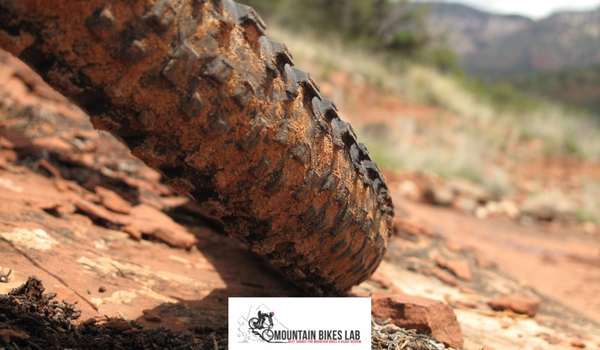
The type of tires you use can make a big difference in your performance. If you’re racing on dry, hardpacked trails, you’ll want to use a tire with low rolling resistance. This will help you to go faster with less effort.
If you’re racing on wet or loose trails, you’ll want to use a tire with more tread. This will provide more grip and help you to avoid slipping and sliding.
It’s also important to choose the right width for your tires. Wide tires provide more traction and stability, but they also weigh more and can slow you down. Narrower tires are lighter and faster, but they don’t provide as much grip.
The best width for your tires will depend on the conditions of the race, your bike, and your riding style. Talk to a local bike shop or an experienced rider to find the right tires for your needs.
12. Get your bike tuned up
If you want to be at your best on race day, it’s important to make sure your bike is in good working condition. This means getting a tune-up before the race. A tune-up will ensure that all of your bike’s parts are properly adjusted and lubricated.
It’s also a good idea to clean your bike before the race. This will help to keep it running smoothly and prevent any mechanical problems.
13. Practice your skills.
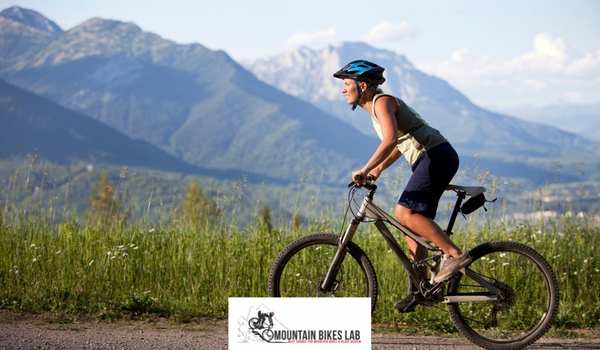
One of the best ways to prepare for a mountain bike race is to practice your skills. If you can master the technical aspects of riding, you’ll be able to ride faster and with more confidence on race day.
So take some time to practice your cornering, braking, and other riding techniques. You can do this by taking a skills class, practicing on an obstacle course, or simply riding on different types of terrain. The more you practice, the better prepared you’ll be for the race.
14. Do some interval training
Interval training is a type of workout that alternates between periods of intense effort and periods of rest. This type of training is ideal for mountain bikers because it helps to improve your endurance and riding speed.
To do interval training, you can ride at a high intensity for a few minutes, then recover for a minute or two. Repeat this cycle several times. You can also do intervals on an uphill section of trail, pedaling as hard as you can for a minute, then recovering on the way down.
Whatever type of interval training you do, make sure to start slowly and gradually increase the intensity over time. And be sure to warm up before and cool down after your workout.
15. Start slow
One of the biggest mistakes that mountain bike racers make is going out too hard in the beginning of the race. This is because the adrenaline is flowing and it’s easy to get caught up in the moment. But starting too fast will only lead to fatigue later on in the race. So instead of going out like a bat out of hell, take it easy at the start and gradually increase your pace as the race goes on. This will help you conserve your energy and make sure you have enough left in the tank for a strong finish.
16. Know your limits
One of the most important things to remember when racing is to know your limits. This means knowing how hard you can push yourself without blowing up. And this takes practice. The best way to learn your limits is to race often and pay attention to how your body responds.
Over time, you’ll start to get a feel for how hard you can go without hitting the wall. And as you become more experienced, you’ll be able to push your limits further and further. So don’t be afraid to race often and experiment with different paces. The more you race, the better you’ll become at knowing your limits.
17. Don’t forget to eat AND Eat right

Another important tip for mountain bike racing is to make sure you’re eating enough. This is because when you’re racing, your body is burning a lot of calories. And if you’re not replenishing those calories, you’ll quickly run out of energy.
So during long races, it’s important to eat regularly to keep your energy levels up. Some good options for race food include energy bars, gels, and chews. And make sure to wash it down with plenty of fluids. By eating and drinking regularly during the race, you’ll be able to keep your energy levels up and avoid bonking.
Why eating right is important before your mountain bike race
You are what you eat, and this is especially true when it comes to mountain bike racing. Eating the right foods will help to increase your energy levels and stamina, while eating the wrong foods will only end up making you tired and sluggish. So what are the best foods to eat before a race?
Some great pre-race foods include:
Oatmeal
This is a great source of complex carbohydrates, which will give you sustained energy throughout the race. Oatmeal is also easy on the stomach, so it’s less likely to cause any gastrointestinal issues. Studies have shown that oatmeal can also help to improve exercise performance.
Bananas
Bananas are a great source of potassium, which is an electrolyte that helps to prevent cramping. They’re also a good source of carbohydrates and vitamin B6, which has been shown to increase energy levels. And like oatmeal, bananas are easy on the stomach and unlikely to cause any GI issues.
Eggs
Eggs are a great source of protein, which is essential for repairing muscles after a hard ride. They’re also packed with vitamins and minerals, such as iron, zinc, and selenium. And studies have shown that eggs can help to improve exercise performance.
Nuts and Seeds
Nuts and seeds are a great source of healthy fats, which can help to increase energy levels. They’re also packed with vitamins, minerals, and antioxidants. Just make sure to avoid nuts and seeds that are covered in salt or sugar.
Dark Chocolate
Dark chocolate is a great source of antioxidants and flavonoids, which can help to improve blood flow and oxygen uptake. It’s also a good source of carbohydrates and healthy fats. Just make sure to choose dark chocolate with a high cocoa content (70% or higher).
Apples
Apples are a great source of fiber, which can help to regulate digestion. They’re also a good source of vitamins A and C, as well as potassium. And like bananas, apples can help to prevent cramping.
Green Vegetables
Green vegetables are a great source of vitamins, minerals, and antioxidants. They’re also a good source of fiber, which can help to regulate digestion. Just make sure to avoid green vegetables that are high in oxalates, such as spinach and Swiss chard.
Yogurt
Yogurt is a great source of protein, calcium, and probiotics. Probiotics are live bacteria that help to improve gut health. And yogurt has been shown to boost immunity and reduce inflammation.
18. Drink enough fluids
Staying hydrated is another important part of mountain bike racing. This is because when you’re sweating, you’re losing important electrolytes that need to be replaced. Otherwise, you’ll start to feel fatigued and your performance will suffer.
So make sure to drink plenty of fluids during the race. A good rule of thumb is to drink about one bottle per hour. And if it’s hot out, you may need to drink even more. So don’t be afraid to drink often and keep your body hydrated.
19. Dress for the conditions
Another important tip for mountain bike racing is to dress for the conditions. This means wearing clothing that will keep you cool in the heat and warm in the cold. And it also means wearing clothing that won’t get in the way or cause you to overheat.
So make sure to dress appropriately for the weather conditions on race day. By doing so, you’ll be able to stay comfortable and perform at your best.
20. Don’t forget about safety (23 Safety Tips For Your Mountain Bike Race)
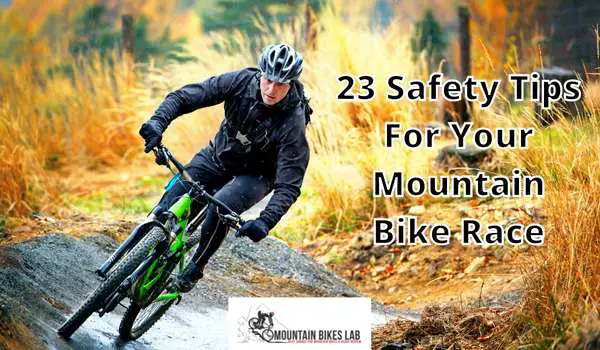
Mountain bike racing can be a dangerous sport. So it’s important to always wear a helmet and follow the rules of the trail. And if you’re racing in an organized event, make sure to follow the race director’s safety guidelines.
What are our best safety tips during your mountain bike race?
In order to stay safe while mountain bike racing, here are the best tips that we have to offer.
Wear a helmet.
Wearing a helmet is the most important thing you can do to stay safe while mountain biking. A helmet will protect your head in the event of a crash and could potentially save your life.
Follow the rules of the trail.
When mountain biking, it’s important to follow the rules of the trail. These rules are in place to help keep everyone safe and to minimize the impact on the trail.
Wear sunscreen and insect repellent.
When racing in the mountains, it’s important to wear sunscreen and insect repellent. The sun can be intense at high altitudes, so it’s important to protect your skin. And insect repellent will help to keep bugs away, which can be a distraction while racing.
Ride within your ability.
One of the most important safety tips is to ride within your ability. This means knowing your limits and not pushing yourself beyond them. If you’re unsure about a section of trail, it’s better to walk it than to try it and risk getting hurt.
Be aware of your surroundings.
When mountain biking, it’s important to be aware of your surroundings. This means looking ahead for obstacles and being aware of the people and animals around you.
Use proper safety gear.
It’s very important to use proper safety gear in your race. This includes a helmet, gloves, elbow and knee pads, and glasses or goggles.
Use hand signals to communicate with other riders.
When mountain biking, it’s important to use hand signals to communicate with other riders. This will help to avoid crashes and to let other riders know what you’re doing.
Be respectful of other trail users.
It’s crucial to be considerate of other trail users when mountain biking. Hikers, horseback riders, and other mountain bikers are all examples of this.
Yield to uphill traffic.
When riding down a mountain, it is customary to yield to uphill traffic. This implies that if you’re going down and someone else is approaching up, you should let them pass.
Don’t ride on wet trails.
When mountain biking, it’s important to avoid riding on wet trails. This can damage the trail and make it more difficult for other users.
Don’t ride around blind corners.
It’s critical to stay away from blind curves when mountain biking. You may be put in the road of oncoming traffic if you ride around a blind corner while mountain biking.
Be prepared for the unexpected.
When mountain biking, it’s important to be prepared for the unexpected. This means having a plan B in case something goes wrong.
Stay on marked trails.
Staying on marked trails is one of the best ways to avoid getting lost while mountain biking. If you’re unsure about where the trail goes, it’s better to turn back than to risk getting lost.
Control your speed on downhill sections.
It’s important to control your speed on downhill sections when mountain biking. This will help you to avoid crashing and to maintain control of your bike.
Do not ride through puddles or mud unless you know what is beneath them.
Puddles can be deeper than they look, so it’s best to avoid riding through them. This could cause you to lose control of your bike or to get wet and cold.
Be aware of changing weather conditions.
Mountain biking can be dangerous in inclement weather, so it’s important to be aware of the forecast before heading out. If the weather looks like it might turn, it’s best to turn back or to seek shelter.
Bring a map and a compass.
If you’re planning on doing any exploration while mountain biking, it’s crucial to bring a map and a compass. This way, if
Be aware of obstacles in the trail, such as rocks, roots, and logs.
It’s important to be aware of obstacles in the trail, such as rocks, roots, and logs. These can be difficult to see, so it’s important to pay attention to the trail and to ride cautiously.
Do not attempt stunts that are beyond your skill level.
Mountain biking can be dangerous, so it’s important to only attempt stunts that are within your skill level. If you’re unsure about a stunt, it’s better to walk it than to try it and risk getting hurt.
If you must dismount, do so on the downhill side of the obstacle.
If you need to dismount, it’s best to do so on the downhill side of the obstacle. This will help you to avoid getting hurt or losing control of your bike.
Bring a cell phone or other means of communication in case of emergency.
If you’re mountain biking, it’s important to bring a cell phone or other means of communication in case of emergency. This way, you can call for help if something goes wrong.
Carry a small first-aid kit.
A small first-aid kit is a good idea to have when mountain biking. This way, you can treat minor injuries if they occur.
Wear brightly colored clothing to increase your visibility to other trail users.
Wearing brightly colored clothing is a good way to increase your visibility to other trail users. This can help you to avoid collisions and to be seen more easily if you need to call for help.
By following these safety tips, you’ll help keep yourself and others safe while racing.
21. Be prepared for mechanicals
One of the unfortunate realities of mountain bike racing is that mechanical problems can happen at any time. So it’s important to be prepared for them. This means having a few essential tools with you on race day, such as a pump, multi-tool, and spare tire.
And it also means knowing how to fix common problems, such as a flat tire or a broken chain. By being prepared for mechanicals, you’ll be able to fix the problem and get back on the trail quickly.
22. Don’t get discouraged
Mountain bike racing can be tough. And there will be times when you get discouraged. But it’s important to remember that everyone has bad days. And the key is to learn from your mistakes and keep trying.
So if you have a bad race, don’t get too down on yourself. Just take some time to reflect on what went wrong and then start planning for your next race. With enough persistence, you’ll eventually reach your goals.
23. Have fun!
At the end of the day, mountain bike racing is supposed to be fun. So make sure to enjoy yourself out on the trail. Take in the scenery and challenge yourself. And most importantly, don’t take yourself too seriously.
By following these tips, you’ll be sure to have a good time while racing. And who knows, you might even surprise yourself with a podium finish.
24. Get Some Rest + Some Relaxing Activities to Try Before Your Race
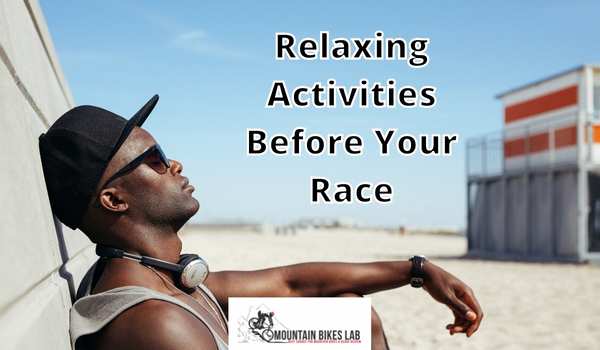
When it comes to mountain bike racing, the key to success is simple: get some rest. That’s right, while your competitors are out training hard and pushing themselves to the limit, you can be lying in bed, getting all the sleep you need to make sure you’re fresh for race day. Of course, this isn’t to say that you don’t need to put in any effort – you still need to put in some quality time on the bike. But by getting enough rest, you’ll make sure that you’re able to give it your all when it counts. So next time you’re feeling tempted to push yourself too hard in training, think about how good a few extra hours of sleep will feel – and how much it could help your performance on race day.
What are some of the relaxing activities you can do before the race day?
Some of the relaxing activities you can do before the race day include:
Listening to music
This will help you to clear your mind and focus on the race. Music is also a great way to get pumped up before the race. The hormones released when you listen to music can help to increase your alertness and energy levels. Another thing to consider is what type of music you listen to. Some relaxing music can go a long way when it comes to preparing for the mountain bike race. In addition, you should also make sure to avoid any music that is too fast-paced or energetic, as this could end up making you more anxious.
Spending time with friends and family
This is a great way to relax and de-stress before the race. Spending time with loved ones can help to take your mind off of the race and allow you to focus on the positive things in your life. In addition, being around people who care about you can help to increase your confidence levels.
Reading
This is another great way to clear your mind and focus on the task at hand. When you read, you are able to escape into another world and forget about all of your troubles. This can be a great way to relax before the race. In addition, reading can also help to increase your knowledge about the sport of mountain biking, which can be helpful on race day.
Yoga
This is a great way to relax both your mind and body. Yoga can help to increase your flexibility and strength, both of which can be helpful on race day. In addition, yoga can also help to improve your balance and focus, two things that are essential when racing. Studies have also shown that yoga can help to decrease anxiety and stress, both of which can be helpful when preparing for a race.
25. Try visualization

Visualization is a powerful tool that can help you to achieve your goals. And it’s especially useful for mountain bike racing. By visualizing yourself crossing the finish line, you’ll be able to increase your motivation and confidence levels. In addition, visualization can also help to improve your focus and concentration.
Law of attraction and visualization go hand in hand. So if you’re not familiar with the law of attraction, it’s basically the belief that you can attract what you want into your life. And byvisualizing yourself crossing the finish line, you’re effectively attracting that result into your life.
So how do you go about visualizing your success in your upcoming mountain bike race?
First, find a quiet place where you won’t be distracted. Then close your eyes and imagine yourself crossing the finish line. Visualize every detail, from the way the sun is shining to the feeling of crossing the line. The more vivid and realistic your visualization, the better.
Once you have a clear image in your mind, hold on to that feeling of success and let it motivate you to take action. Remember, anything is possible if you believe it is. So believe in yourself and your ability to succeed, and you’ll be one step closer to crossing the finish line.
If you have not watched the movie “The Secret” or read the book, I highly recommend doing so. It is all about the law of attraction and how you can use it to attract what you want into your life. You could easily incorporate the principles in this movie to your mountain bike race. There are some very powerful scenes in the movie that can help to increase your motivation. The concepts are proven and have worked for many people, so there’s no reason why they can’t work for you.
26. Make a plan
One of the best ways to prepare for a mountain bike race is to make a plan. By having a plan, you’ll be able to focus on what’s important and make sure that you’re prepared for every eventuality.
So what should you include in your plan? First, you’ll need to decide what type of race you’re going to enter. There are many different types of mountain bike races, so it’s important to choose one that’s right for you. Once you’ve decided on the type of race, you can start to map out your training.
Your training should be specific to the type of race you’re doing. For example, if you’re doing a cross-country race, you’ll need to focus on endurance training. But if you’re doing a downhill race, you’ll need to focus on power and strength training.
In addition to your training, your plan should also include a nutrition plan. Eating the right foods will help to improve your performance on race day. And finally, don’t forget to include a rest and recovery plan. This is essential for preventing injuries and avoiding burnout.
27. Stay hydrated
Staying hydrated is essential for both your health and your performance. When you’re riding, your body loses a lot of water through sweat. And if you don’t replace that lost fluid, you’ll quickly become dehydrated. Dehydration can lead to fatigue, cramping, and even heat stroke.
So how much water should you be drinking? Most experts recommend that athletes drink between 2 and 3 liters of water per day. But during intense training or racing, you may need to drink even more. A good rule of thumb is to drink enough so that your urine is clear or pale yellow. If it’s dark yellow, that’s a sign that you’re not drinking enough.
In addition to water, you may also want to consider electrolyte drinks. These drinks can help to replenish the electrolytes that are lost through sweat. And if you’re going to be riding for more than an hour, you may want to consider carrying a portable hydration pack. This way, you’ll always have access to water and won’t have to worry about running out.
28. Eat healthy
Eating a healthy diet is essential for both your physical and mental health. When you eat healthy foods, your body gets the nutrients it needs to function properly. And when your body is functioning properly, you’ll have more energy and be able to ride at your best.
So what should you be eating? A diet that’s rich in fruits, vegetables, and whole grains is a good place to start. You should also include lean proteins, such as chicken, fish, and tofu. And don’t forget to include healthy fats, like avocados and nuts. These will help to keep you satiated and provides essential nutrients.
In addition to eating healthy foods, you should also make sure that you’re eating enough. If you’re not getting enough calories, your body won’t have the energy it needs to ride. And if you’re riding for more than an hour, you’ll need to replenish your glycogen stores with a carbohydrate-rich snack or drink.
29. Cool down after your ride
Just as important as warming up is cooling down after your ride. When you cool down, your body starts to remove the lactic acid that has built up in your muscles. This can help to reduce soreness and prevent injuries.
To cool down, simply ride at a easy pace for 10 minutes or so. Then, stretch your muscles to help them recover.
30. Listen to your body
Riding a bike is a physically demanding activity. And when you’re pushing yourself hard, it’s important to listen to your body. If you’re feeling pain or discomfort, slow down or take a break. Ignoring these warning signs can lead to injuries.
In addition to listening for pain, pay attention to other physical cues, such as fatigue and excessive thirst. These can be early warning signs of dehydration or overtraining. If you notice any of these signs, make sure to take a break and reevaluate your training schedule.
31. Take rest days
In addition to getting enough sleep, it’s also important to take rest days. When you’re constantly riding, your body doesn’t have time to recover. This can lead to overtraining, which can lead to injuries and burnout.
So how often should you take a rest day? It depends on how much you’re riding. If you’re only riding a few times per week, you may not need a rest day at all. But if you’re riding every day, you should take at least one day off per week.
32. Cross-train
Cross-training is a great way to stay in shape when you can’t ride. And it can also help to prevent injuries by strengthening muscles that aren’t used during biking.
There are a number of different activities that you can do for cross-training, such as swimming, running, and weightlifting. And you don’t have to do anything fancy – even walking can be helpful. Just make sure that you’re doing something that’s different from biking to get the most benefit.
33. Stay positive
One of the most important things to remember when racing is to stay positive. No matter what happens on the trail, always keep your head up and believe in yourself. If you make a mistake, learn from it and move on. And if you get tired, take a deep breath and keep pedaling. Remember, mountain biking is supposed to be fun. So don’t let anything bring you down. Instead, focus on the enjoying the ride and crossing the finish line with a smile on your face.
34. Set small goals
When you’re racing, it’s important to set small goals. rather than thinking about the entire race, break it down into manageable chunks. For example, if you’re racing for two hours, break it down into 10-minute increments. And if you’re racing for an hour, break it down into 20-minute increments. By setting small goals, you’ll be able to better monitor your progress and make sure that you’re on track to reach your ultimate goal.
35. Don’t compare yourself to others
One of the worst things you can do when racing is compare yourself to others. Instead of worrying about what everyone else is doing, focus on your own race. Trust me, you’ll be much happier and more successful in the long run if you don’t compare yourself to others.
36. Be prepared for anything
One of the most important things to remember when racing is that anything can happen. So it’s important to be prepared for anything and everything. Make sure you have a plan B in case something goes wrong on the trail. And always carry plenty of food and water, just in case you get stranded out on the trail. By being prepared for anything, you’ll be able to better handle whatever comes your way on race day.
37. Don’t overthink it
One of the biggest mistakes you can make when racing is to overthink things. If you start second-guessing yourself, you’ll only end up making things worse. So instead of worrying about every little detail, just relax and let the race come to you. Trust me, you’ll be much happier and more successful in the long run if you don’t overthink things.
Overthinking is one of the biggest mistakes you can make when racing. If you start second-guessing yourself, you’ll only end up making things worse.
Like we mentioned before, try to stay positive and visualize yourself crossing the finish line. And if you start to overthink things, just take a deep breath and relax. The more you worry, the worse it’ll be.
38. Get your bike ready
In order to race your best, it’s important to make sure your bike is in good working condition. This means checking things like your brakes, tires, chain, and suspension. If something on your bike isn’t working properly, it could not only affect your performance, but also put you in danger. So before each race, take some time to go through a checklist and make sure everything on your bike is in good working order.
Here are some things to check before each race to get your bike ready.
1. Clean and lubricate your bike.
This is important to do before every race. A clean bike will not only perform better, but will also last longer. You can do this by using a bike-specific cleaner and then lubing your chain.
2. Check your bike’s components.
Before each race, it’s important to check your bike’s components. This includes things like your brakes, tires, chain, and suspension. If something isn’t working properly, it could affect your performance.
3. Adjust your bike’s settings.
Depending on the race, you may need to adjust your bike’s settings. For example, if you’re racing in a downhill event, you’ll want to lower your seat and raise your stem. On the other hand, if you’re racing in an endurance event, you’ll want to raise your seat and lower your stem.
4. Test your bike.
Once you’ve got your bike all dialed in, it’s important to test it out. This will help you get a feel for how it handles and also give you an opportunity to make any final adjustments.
5. Check your tires for wear and tear.
Before each race, it’s important to check your tires for wear and tear. If you see any cracks or bald spots, it’s time to replace them.
6. Inspect your brakes for proper function.
You should also inspect your brakes for proper function. This includes making sure the pads are not worn and the cables are not frayed.
7. Check your chain for wear and tear.
It’s also important to check your chain for wear and tear. If you see any links that are stretched or broken, it’s time to replace it.
8. Test your suspension for proper function.
Last but not least, you should test your suspension for proper function. This includes making sure the forks are not leaking and the shocks are not worn.
9. Tighten all bolts on the bike.
Make sure all bolts are tight on the bike. This includes the stem, handlebars, seatpost, and pedals.
10. Fill up your water bottle and take some snacks with you.
Before you head out for your race, make sure you fill up your water bottle and take some snacks with you. This will help you stay hydrated and fueled during the event.
39. Eat a nutritious breakfast
Eating a nutritious breakfast is one of the best things you can do to prepare for a mountain bike race. Breakfast provides your body with the energy it needs to perform at its best. When choosing what to eat, look for foods that are high in carbohydrates and low in fat. Good options include oatmeal, toast with peanut butter, or a fruit smoothie.
Avoid eating a large breakfast, as this can make you feel sluggish. Instead, aim for a meal that is around 300 calories. And be sure to eat at least an hour before the race so that your food has time to digest.

